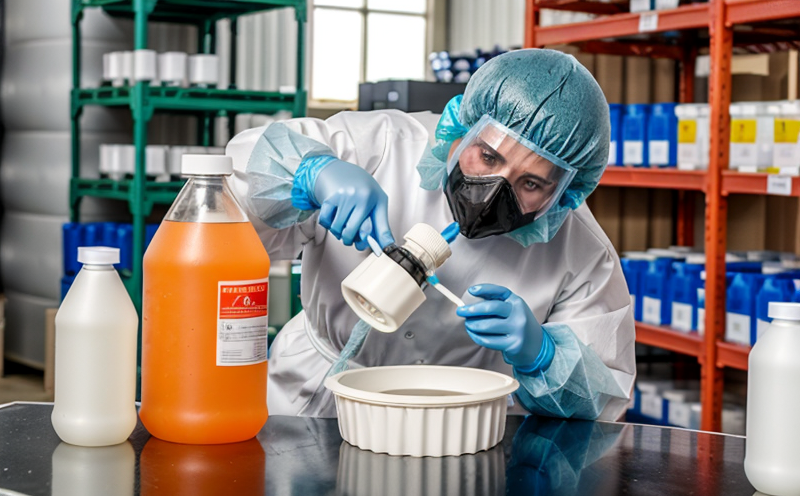ISO 21152 Detection of Pseudomonas aeruginosa in Packaging Materials
The ISO 21152 standard is a critical benchmark for ensuring microbiological safety in packaging materials, particularly those intended for contact with food or pharmaceutical products. This service focuses on the detection and quantification of Pseudomonas aeruginosa, a versatile bacterium that can thrive in various environments, including moisture-rich areas like packaging interiors.
This bacterium is notorious for causing spoilage and contamination issues in packaged goods. It is particularly problematic because it can form biofilms, which are difficult to remove once established. The presence of Pseudomonas aeruginosa not only affects the quality of products but can also pose serious health risks if ingested.
The ISO 21152 protocol involves a multi-step process that begins with the collection and preparation of samples from packaging materials. These samples are then inoculated into selective media designed to inhibit other microorganisms, allowing for the specific growth and detection of Pseudomonas aeruginosa. The test uses a combination of culture-based methods and molecular techniques such as polymerase chain reaction (PCR) to ensure accurate identification.
The standard specifies rigorous acceptance criteria that packaging must meet. These include both quantitative and qualitative parameters, ensuring that the levels of Pseudomonas aeruginosa do not exceed permissible limits. Compliance with ISO 21152 is crucial for manufacturers aiming to maintain high standards in product safety.
The testing procedure also involves extensive quality control measures to ensure reliable results. This includes calibration and validation of test kits, regular monitoring of laboratory conditions, and the use of reference strains to standardize tests. The service ensures that all steps are meticulously followed, providing clients with accurate and trustworthy results.
| Parameter | Description |
|---|---|
| Sample Collection | Systematic sampling of packaging materials to ensure representative samples. |
| Inoculation Method | Use of selective media and incubation conditions optimized for Pseudomonas aeruginosa. |
| Detection Techniques | Culture-based methods combined with PCR to confirm presence. |
| Acceptance Criteria | Quantitative limits based on ISO 21152, ensuring safety standards are met. |
The service also offers detailed reports that outline the testing process and results. These reports are essential for compliance officers and quality managers to make informed decisions about product safety. The use of advanced molecular techniques ensures that even trace amounts of Pseudomonas aeruginosa can be detected, providing an extra layer of security.
The importance of this service cannot be overstated in the context of food and pharmaceutical packaging. By adhering to ISO 21152 standards, manufacturers can ensure that their products are free from contamination and meet international safety guidelines. This not only protects consumers but also enhances brand reputation and regulatory compliance.
Industry Applications
The detection of Pseudomonas aeruginosa in packaging materials is particularly relevant for industries where microbial contamination can lead to significant economic losses. This service finds application in the food, pharmaceutical, and medical device sectors.
| Sector | Description |
|---|---|
| Food Industry | The presence of Pseudomonas aeruginosa can lead to spoilage and contamination, affecting product quality and safety. |
| Pharmaceutical Industry | Contamination with this bacterium can compromise the efficacy and safety of medicinal products. |
| Medical Device Manufacturing | The use of packaging that harbors Pseudomonas aeruginosa can lead to infections, posing serious health risks. |
In each sector, the service plays a crucial role in ensuring product safety and compliance with international standards. The ability to detect Pseudomonas aeruginosa early in the supply chain can prevent costly recalls and legal issues.
Customer Impact and Satisfaction
- Enhanced product safety, reducing the risk of contamination and spoilage.
- Improved brand reputation through adherence to international standards.
- Maintained regulatory compliance, avoiding fines and legal actions.
- Increased consumer confidence in product quality and health benefits.
Customers benefit from this service by receiving reliable test results that ensure their products meet the highest safety standards. The detailed reports provided are invaluable tools for making informed decisions about production processes and packaging materials.
Use Cases and Application Examples
| Case Study | Description |
|---|---|
| Food Manufacturer | A major food manufacturer used this service to detect Pseudomonas aeruginosa in its packaging. The testing revealed trace amounts of the bacterium, which were promptly addressed through a change in packaging material. |
| Pharmaceutical Company | A pharmaceutical company utilized ISO 21152 to ensure that their product packaging was free from Pseudomonas aeruginosa. The service helped them maintain compliance with stringent regulatory requirements, protecting patient health. |
| Medical Device Manufacturer | A medical device manufacturer applied this service to enhance the safety of its packaging. By ensuring that no Pseudomonas aeruginosa is present in their packaging, they minimized the risk of infections and other health risks associated with contaminated products. |
These examples illustrate how ISO 21152 plays a vital role in maintaining product safety across various industries. The service ensures that manufacturers can trust the quality of their packaging materials, thereby protecting both consumers and themselves from potential risks.





